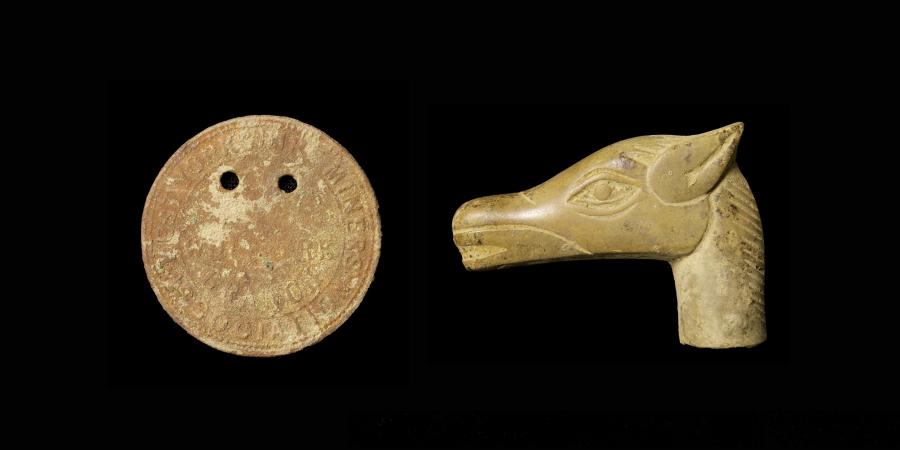About Sheffield YAC
Sheffield YAC has been running for over 20 years and has been a very successful group, our age range is 8-16 year olds and we aim to give them as many opportunities as possible to take part in 'all things archaeological' with as much hands on experiences as possible. We have been supported for many years by Sheffield University students and lecturers, Weston Park Museum and their staff and other local museums, we enjoy taking the children out on field trips during the spring and summer to as many locations as we can.
2020 has proved a challenge but thanks to Wessex Archaeology and the YAC website we have started to provide online sessions once a month for them with more planned with Sheffield Uni, Wessex and our own leaders, but most of all we look forward to getting back to normal and getting out to places with our group.
The Sheffield YAC group have kindly given permission for us to share their images and artworks created created as part of these sessions.



"I enjoyed looking at the 4 objects, and making my own museum."
"The session was interesting because they showed four artefacts found on different archaeological digs."
"I found the objects interesting because of how different they were."
"It was nice to learn about ‘old Sheffield."
"Learnt lots of new things about technology and how it is being used."



"I am really enjoying the sessions."
"Really enjoyed the whole experience, Wessex staff were great and related to the children extremely well."
"I've enjoyed stepping outside of my day-to-day (lots of thesis writing) and share my love of archaeology with the group and with Wessex. It's the most I've spoken to people about archaeology since lockdown started!"


"I've developed confidence in participating in digital events as a group leader, and got lots of ideas for how we can run digital sessions in future. I also learned about some fun new objects!"
"It was very inclusive, sharing objects with individuals who wouldn't otherwise see them, especially as schools don't work with objects in the same way."
"The mining token is a fascinating bit of local heritage - I loved that you could show the X-ray scans to the group. I also liked the poo token because it's pretty gross but also gets at lots of different archaeological ideas - the reuse and discard of materials, the ambiguity of archaeological assemblages, the different ways you can look at an object."

"As a YAC leader, it's been a really great experience to learn from the experts and participate in a digital activity - we've really missed being together as a group so it was fun to do something structured but also with opportunities for discussion. The group seemed really engaged and it looked like they learned a lot, especially with the home tasks and watching the 3D scans - when they're happy, I'm happy!"
The Sheffield YAC group have selected two objects from our archives to go into this online museum. Please do explore the objects below, we hope you enjoy them.
19th century miner's token
A miner’s token from the Whitkirk branch of the West Yorkshire Miners Association. Mining tokens were originally issued by mining companies as a simple tally to count miners in and out of the mine, but later versions are stamped with the same information as an individual miner’s lamp so that the company knew exactly who was underground at any one time. This token is slightly different, as it has been issued by a Miners Association rather than mining company or colliery. Miners Associations issued membership badges to their paid-up members. The West Yorkshire Miners Association was founded in 1858 following a wage cut that saw many miners go on strike. After several decades of negotiation the West Yorkshire Miners Association merged with the South Yorkshire Miners Association in 1881 to form the Yorkshire Miners Association.
19th - 20th century horse head fitting
A 19th – 20th century stylised horse head fitting, probably the handle of a walking stick. Walking sticks are probably as old as humankind, and even gorillas in the wild have been observed using a branch as a walking aid. In the past a walking stick was often seen as a symbol of authority or even a weapon – Henry VIII was reportedly very fond of his walking stick, which featured spikes and concealed pistols, and is on display in the Tower of London. By the 1600s gentlemen had begun to carry a cane as part of their everyday dress instead of a sword. These canes became more ornate and less functional as time went on. In 1702 London started to require gentlemen to hold a walking stick licence to ensure proper etiquette was observed. Improper use – such as holding the stick under the arm – could mean that the licence was forfeit. In 1984 the British Stickmakers Guild was founded to preserve traditional manufacturing techniques.
Return to the Lost and Found Museum home page
